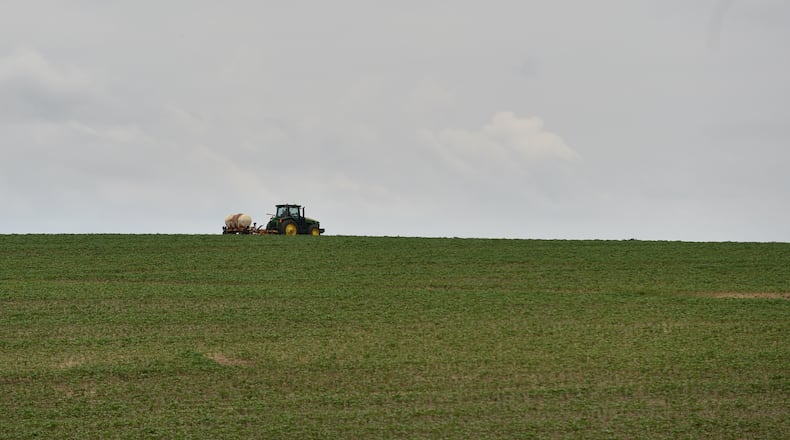Joe Boddiford planted 2,300 acres of corn, cotton and peanuts this year in Screven County in southeast Georgia. But a war 5,000 miles away will determine, in large part, whether his harvest is a financial success.
Costs have skyrocketed for Boddiford and other Georgia farmers since Russia’s invasion of Ukraine.
Russia is a top exporter of products that keep the agricultural world in balance — fuel and fertilizers. And, while the U.S. doesn’t buy much of that from Russia, that doesn’t mean American farmers don’t feel the pinch.
Economic sanctions that were levied to punish Russia’s aggression, along with closed ports, have stanched the flow of that country’s products into world markets. Because of that, other suppliers have seen increasing demand, which is causing prices to shoot up globally.
“Everything is up, and we don’t know where it’s going to end,” said Carroll Hopkins who grows tomatoes, squash, peppers and other vegetables on 100 acres in Grady County on the Florida state line.
Russia accounts for 16.5% of global nitrogen, 16.5% of potassium and 12.7% of phosphate, according to Veronica Nigh, senior economist with the American Farm Bureau Federation. It is also a major producer of urea and ammonia, critical for farming.
Boddiford said one fertilizer that cost him $393 a ton 15 month ago now is going for $1,430. And the diesel fuel that he buys 7,500 gallons at a time cost him $1.50 more per gallon this spring compared to last year.
Higher fuel prices means it costs more to ship his products to market, and the cost of pesticides, many of which are made from petroleum, are also up.
Taking a break from his tractor last week, Boddiford said he’s worried. “The longer it lasts, it won’t be just a blip on the radar.” It could affect everyone, he said, from farmers to consumers, who will be forced to deal with eventual increased food prices.
University of Georgia agricultural economists Amanda Smith and Yangxuan Liu estimate that farmers’ costs to grow corn will rise from $356 to $460 per acre; for cotton from $465 to $623; for peanuts from $615 to $663; and for wheat from $217 to $346. And that’s on unirrigated land. It costs more for irrigated land because it takes fuel or electricity to run water pumps.
Russia and Ukraine are also food exporters that account for 30% of the world’s wheat. Ukraine is the fourth largest corn exporter and counts $16 billion worth of other food exports, Nigh said. But their exports and the spring planting season have been disrupted.
That means higher global prices for grains. And those costs will also trickle down, said Tom Hensley, the president of Georgia’s Fieldale Farms, a chicken producer. He said rising prices for corn — a major component of poultry feed — means “the price of meat is high and is going to go higher.”
Corn that was selling on the Chicago commodity market in January for $6.06 a bushel was selling for $7.54 in late March. Wheat has risen from $7.58 to $11.02.
Georgia farmers could benefit from that. Better prices could offset their additional costs.
Farm Bureau economist Nigh said that, if the war in Ukraine ends soon, the commodities markets would probably stabilize fairly quickly and prices may even come down.
That could hurt Georgia farmers who plant at a high cost but harvest after prices return to more normal levels.
Farming is still the state’s largest single industry. The food and fiber industry had $69.4 billion in state output in 2020, according to the latest numbers from the University of Georgia.
Russia’s invasion of Ukraine is just the latest in a series of blows that Georgia farmers have been struggling with.
In 2018, President Donald Trump started a trade war with China and some other countries to try to force them to the negotiating table. China retaliated, putting tariffs on American commodities, including Georgia staples like pecans and cotton. Negotiations have eased some tariffs, and U.S. agricultural sales to China are growing again.
Also, farms are still dealing with the ripple effects of the COVID-19 pandemic. Labor and supply chains disruptions have driven up prices and made it difficult and more expensive to get everything from tractor parts to boxes and wooden pallets that are used to ship products. Boddiford has a friend whose field work has been delayed by several weeks as he waits for a tractor part to arrive.
Despite the uncertainties, Hopkins, the 68-year-old Grady County farmer, said, “I’m always optimistic.”
“Every year, things look bad, and you are putting all the money out now and then worried if you are going to get it back at the end of the year,” he said. “I am always thinking I am going to make some money and stay one more year. That’s the way I feel right now.”
About the Author
Keep Reading
The Latest
Featured



